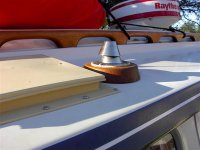After almost two years of trying to find out why our cabin floor keeps getting wet, we think we may finally have tracked it down to 2 problems:
* The shower drains into a small plastic box that houses a sump pump that is supposed to pump that water over the side. The sump pump quit working, so any water in the shower ended up in the cabin. (This is now fixed.)
* The current problem is the exhaust pipe from the Wallas stove. I think the actual problem is that when we're in rough water, spray enters the exhaust pipe, then shoots up past the end of the pipe and leaks back down the outside of the pipe. (Because the flexible metal tube that connects from the stove to the exhaust pipe does not make a perfect seal around the pipe.) I pretty much proved this by spraying a hose at the outside exhaust pipe opening and watching it drip out.
So my plan was to:
1) re-seal the flexible tubing to the exhaust pipe so that any water that entered the pipe would not be allowed to leak back out.
2) install a big clam shell over the exhaust pipe opening on the outside of the boat, to stop spray from getting in in the first place.
The question is this: when we talked to a local marine shop about this, (Harbor Marine, in Everett, WA), they advised not to install the clam shell. The said that the heat from the exhaust would damage the gel coat and result in fibreglass repairs down the road. Does anyone have any thought on this? There are some very large clam shells that stand off a good inch or two from the mounting surface, I have a hard time believing that would allow the exhaust to heat up the gel coat enough to damage it. But I'd hate to find out the hard way.
Any thoughts?
Thanks in advance...
Tom and Sherry on the Caution Horse
* The shower drains into a small plastic box that houses a sump pump that is supposed to pump that water over the side. The sump pump quit working, so any water in the shower ended up in the cabin. (This is now fixed.)
* The current problem is the exhaust pipe from the Wallas stove. I think the actual problem is that when we're in rough water, spray enters the exhaust pipe, then shoots up past the end of the pipe and leaks back down the outside of the pipe. (Because the flexible metal tube that connects from the stove to the exhaust pipe does not make a perfect seal around the pipe.) I pretty much proved this by spraying a hose at the outside exhaust pipe opening and watching it drip out.
So my plan was to:
1) re-seal the flexible tubing to the exhaust pipe so that any water that entered the pipe would not be allowed to leak back out.
2) install a big clam shell over the exhaust pipe opening on the outside of the boat, to stop spray from getting in in the first place.
The question is this: when we talked to a local marine shop about this, (Harbor Marine, in Everett, WA), they advised not to install the clam shell. The said that the heat from the exhaust would damage the gel coat and result in fibreglass repairs down the road. Does anyone have any thought on this? There are some very large clam shells that stand off a good inch or two from the mounting surface, I have a hard time believing that would allow the exhaust to heat up the gel coat enough to damage it. But I'd hate to find out the hard way.
Any thoughts?
Thanks in advance...
Tom and Sherry on the Caution Horse

